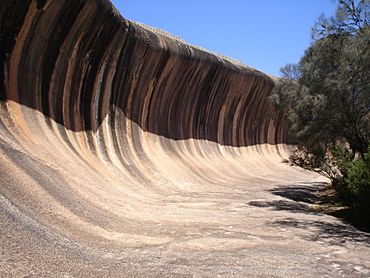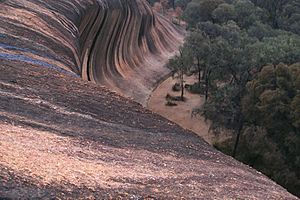Wave Rock facts for kids
Quick facts for kids Wave RockWestern Australia |
|
|---|---|
 |
|
| Lua error in Module:Location_map at line 416: Malformed coordinates value. | |
| Location | |
| Designations | |
|---|---|
| Official name | Wave Rock & Environs |
| Type | Aboriginal Heritage Sites Register |
| Designated | 21 August 1995 |
| Reference no. | 4466 |
| Status | Registered |
| Official name | Wave Rock and Environs |
| Type | Natural |
| Reference no. | 17137 |
| Place File Number | 5/06/099/0004 |
Wave Rock (called Katter Kich by the Ballardong people) is a natural rock formation in Western Australia. It looks just like a huge ocean wave about to break!
This amazing rock is about 15 meters (49 feet) high and 110 meters (360 feet) long. It forms one side of a hill known as "Hyden Rock." This granite hill is located about 3 kilometers (2 miles) east of the small town of Hyden. It's also about 296 kilometers (184 miles) east-southeast of Perth, the capital of Western Australia.
Wave Rock and Hyden Rock are part of a 160-hectare (400-acre) nature reserve called Hyden Wildlife Park. More than 100,000 tourists visit this special place every year.
Contents
Collecting Water at Wave Rock
Above Wave Rock, there is a low wall built into the side of Hyden Rock. This wall helps to collect rainwater. It guides the water down the rock surface into a storage dam.
This wall and dam were built in December 1928. They were made by the Public Works Department to provide water for the early settlers in the East Karlgarin District. The wall and dam were updated in 1951 to hold even more water for the town of Hyden. You can see similar walls on many other rocks in the Wheatbelt region.
Dreamtime Stories of Wave Rock
Wave Rock is very important to the Ballardong people, who are the traditional owners of this land. They call it Katter Kich.
Local tribes have a Dreamtime story about how Wave Rock was created. They believe the Rainbow Serpent formed it. The story says she dragged her swollen body over the land after drinking all the water. This created the wave shape.
The Ballardong people respected this area as a place for cultural learning. The Dreamtime tale taught them important lessons for life. Wave Rock is part of a long "dreaming trail." This trail stretches from the south coast near Augusta all the way to the Great Victoria Desert in the north-east. Other important places along this trail include Mulka's Cave, Puntapin Rock, Jilakin Rock, Jitarning Rock, and Dumbleyung Lake.
How Wave Rock Was Formed
Wave Rock is part of Hyden Rock, which is a very old granite rock. It is about 2.63 billion years old! Hyden Rock is a type of rock formation called an inselberg. An inselberg is a lonely hill that stands out from a flat plain.
Wave Rock is a great example of a "flared slope." This is a rock surface that curves inward or upward, often found at the bottom of large rocks or hills. Flared slopes like Wave Rock are common in the granite areas of south-western Australia.
Scientists believe these flared slopes formed over millions of years. Water soaking into the ground slowly weathered (broke down) the granite rock underground. This created softer pockets of rock. As the land around the inselberg wore away, these softer pockets were removed, leaving behind the hard, curved "wave" shape we see today.
A local Noongar man and tour guide, Michael Ward, says that the wall built above Wave Rock has changed its color over time. He remembers the rock being lighter yellow or cream when the wall was first built. Now, the wall has helped it become red and orange, with black streaks on its surface.
Other Cool Rocks Nearby
There are other interesting rock formations close to Wave Rock. These include Hippos Yawn, which looks like a giant hippo's mouth, and The Humps.
See also
 In Spanish: Wave Rock para niños
In Spanish: Wave Rock para niños
- List of individual rocks


